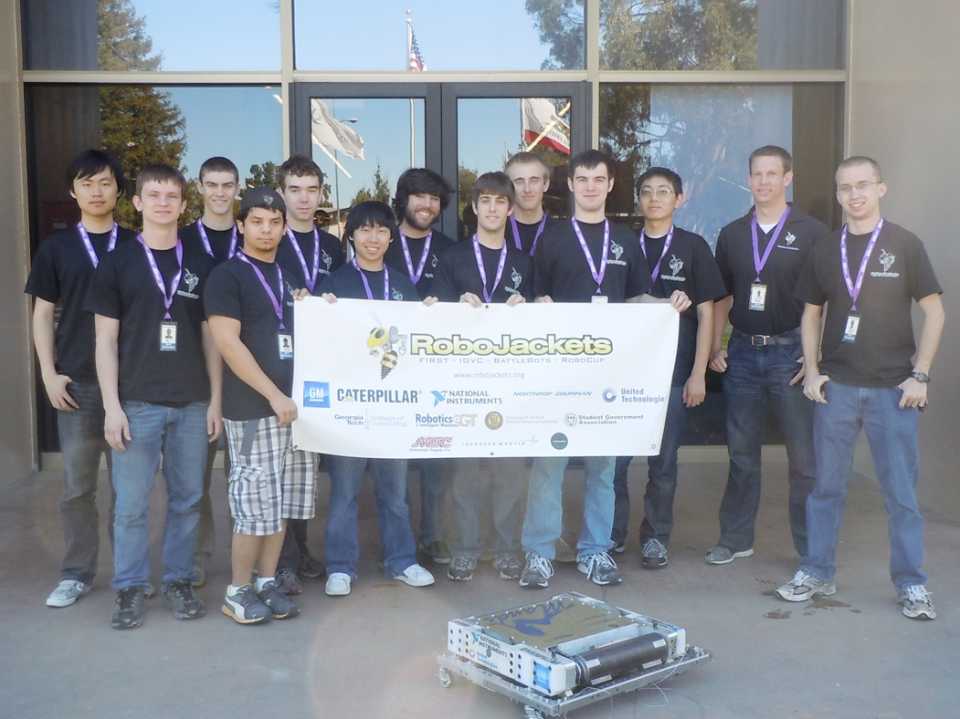For some students, applying what they’ve learned in the classroom to real-world scenarios won’t happen until they leave Tech’s labs and lecture halls. For members of RoboJackets, however, applying engineering principles is part of the job.
RoboJackets, a robotics club made up of Tech students, faculty and alumni, share an interest in building machines, programming software and competing against their peers.
“I joined RoboJackets because I was interested in hands-on designing and building. I remember watching BattleBots on TV as a kid and thinking that it would be really cool to build one some day,” said Kevin Umana, a fifth-year AE major and Project Manager for the BattleBots team.
The organization is made up of four teams that participate in competitions throughout the year. Each team works on various projects with different design parameters and goals.
The Intelligent Ground Vehicle Competition (IGVC) group works on 300-pound autonomous robots which operate outdoors in off-road conditions. Obstacles have to be avoided by the robot alone without a human controller.
The IGVC group competes in an annual competition held by the Association of Unmanned Vehicle Systems where thirty teams put their robots through a course given by GPS waypoints.
RoboCup teams design autonomous robots. The robots are smaller and compete in soccer tournaments against other autonomous robots in teams of six.
The robots must communicate with each other to outsmart their opponents.
The RoboCup team has competed in tournaments around the world since 2007.
“My favorite event so far has been the RoboCup 2011 in Istanbul, Turkey. It was a lot of fun meeting other teams and making new friends at these events. Also it gave me the opportunity to travel,” said Nikolaus Mitchell, a third-year ME major.
The team is currently working on its robots for the 2013 RoboCup, which will be held in Eindhoven, The Netherlands.
The third competitive team, BattleBots, builds medium-sized robots that can withstand constant pummeling. Robots are pitted one on one against each other in an arena while under the control of a human driver.
The nature of BattleBots largely requires mechanical skills to make the most durable robot possible, but electrical and programming skills are still necessary.
“One of the biggest skills I have learned is how to machine metal into useful parts. I have also learned a great deal about electronics that were never taught in the classes I’ve taken,” Umana said.
This April, the BattleBots team will travel to San Mateo, Calif. to compete in RoboGames.
The outreach mentorship program FIRST (For Inspiration and Recognition of Science and Technology) organizes events to reach out to high school students interested in robotics.
In January, the annual kick-off event was held in Ferst Center. Over 900 students representing 50 high schools attended to listen to guest speakers, receive giveaways, participate in workshops and discover this year’s challenge.
This year’s challenge is to build a robot that can throw Frisbees into goals. At the kick-off event, members of RoboJackets gave mechanics, electrical and programming workshops to high school students. The students will have six weeks to make a robot ready for competition.
“I have two favorite events—the kick-off and the FIRST Robotics Competition (FRC). It consists of two days of frantic testing, competing and repairing whatever happens to go wrong,” said Alex Eng, a third-year NRE major.
Last year, a team mentored by RoboJackets made it to the semifinals of the elimination round.
In addition to its four main teams, RoboJackets conducts independent research on control systems and new designs which could be used in future competition robots. RoboJackets also participates in soap box derby competitions, working with GT Off-Road—an organization that designs and builds an off-road vehicle for competitions.
“In school you learn a lot of theory. In our club you’ll actually get your hands dirty by designing, programming and building robots,” said Jordan Mazaira, a fifth-year ME major and president of RoboJackets.
